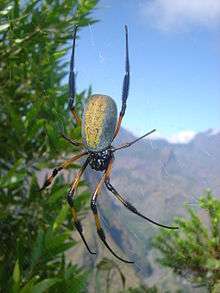Nephila inaurata
Nephila inaurata, commonly known as the red-legged golden orb-weaver spider or red-legged nephila, is a species of golden orb-weaver spider. It is native to southern and East Africa, besides several islands of the western Indian Ocean (Madagascar, the Seychelles, Réunion, Mauritius, Rodrigues).
| Red-legged nephila | |
|---|---|
 | |
| Nominate subspecies in Réunion | |
.jpg) | |
| N. i. subsp. madagascariensis in Mozambique | |
| Scientific classification | |
| Kingdom: | Animalia |
| Phylum: | Arthropoda |
| Subphylum: | Chelicerata |
| Class: | Arachnida |
| Order: | Araneae |
| Infraorder: | Araneomorphae |
| Family: | Araneidae |
| Genus: | Nephila |
| Species: | N. inaurata |
| Binomial name | |
| Nephila inaurata (Walckenaer, 1842)[1] | |
| Synonyms | |
|
Epeira inaurata | |
Habits
Like other spiders in the subfamily Nephilinae it can weave webs so strong that sometimes even birds and bats get caught. Its webs can be found in damp places such as large trees and unpolluted areas to which no cars have access; normally several are strung together to form enormous "homes" so as to cover as much surface area as possible.
Prey
This species feeds on flies, mosquitoes, moths, wasps and unfortunate beetles who happen to get tangled up.
Subspecies
In addition to the nominate subspecies (N. i. inaurata) of Mauritius and Réunion,[2] a second subspecies is currently recognized: N. i. madagascariensis (Vinson, 1863), which occurs from South Africa to the Seychelles.
Captive breeding
This species is commonly kept in captivity. Egg sacs the size of a small marble are made of thick silk and contain 100-200 eggs which hatch after two months. They start out with a 2mm leg span and grow rapidly. Males mature in one to two months depending on the form. A small percentage of males mature early and resemble a small, black crab spider with only an 8-10mm leg span. Most males mature later and resemble the form of the female but have very little color and only a 25-30mm leg span. Females mature in four months with an approximate 100mm leg span.[3]
References
- "Taxon details Nephila inaurata (Linnaeus, 1767)", World Spider Catalog, Natural History Museum Bern, retrieved 2017-05-15
- "Family: Araneidae Clerck, 1757". World Spider Catalog Version 19.0. Natural History Museum Bern. 2018. Retrieved 5 July 2018.
- "Golden Silk Spiders", Invertebrate-Magazine Vol.4, Issue 2 March 2005
| Wikimedia Commons has media related to Nephila inaurata. |